Jacksonville Zoo and Gardens
The Jacksonville Zoo and Gardens, located in Jacksonville, Florida, sits at the mouth of the Trout River, near where it flows into the St. Johns River. The zoo occupies approximately 117 acres (47 ha) and has over 2,000 animals and 1,000 plants in its collection. The zoo has grown from its modest beginnings in Springfield to be considered one of the city's premier attractions, with more than one million visitors in the past year.
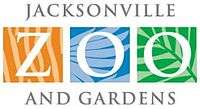 | |
| Date opened | May 12, 1914 |
|---|---|
| Location | 370 Zoo Parkway, Jacksonville, Florida, 32218, United States |
| Coordinates | 30°24′14.67″N 81°38′36.04″W |
| Land area | 117 acres (47 ha) |
| No. of animals | 2,400 |
| Memberships | AZA[1] |
| Website | www |
The Jacksonville Zoo and Gardens' marquee attractions are the Range of the Jaguar, which won the 2005 AZA Exhibit of the year award[2] and the Land of the Tiger, which opened in 2014 and features an innovative walk-through trail system for the two Sumatran and three Malayan tigers. Also included in the Land of the Tiger are wreathed and wrinkled hornbills, Visayan warty pigs, babirusas, and Asian small-clawed otters. The zoo's other exhibits include the Plains of East Africa, highlighting African savanna animals, including three Southern white rhinoceri; the Australian Outback, including lorikeets, cassowaries, and wallabies; African Forest, featuring two of the four genera of great apes, as well as several species of lemurs; and Wild Florida, which features animals native to the state, such as North American river otters, American black bears, Florida panthers, and others.
The zoo is active in animal conservation, participating in more than 50 national and international conservation initiatives and more than 95 Species Survival Plans. In 2004, the zoo reached an agreement with the nation of Guyana to help promote conservation in that country, particularly the Iwokrama Forest. Additionally, since 1999 the zoo has been home to a large breeding colony of wild wood storks. Though not endangered, this bird is a rare find on the North American continent, and has, in this case, taken up permanent residence in a tree overlooking the Plains of Africa.
History
The Municipal Zoo opened in the Springfield neighborhood of Jacksonville, Florida on May 12, 1914. The first animal on exhibit was a red deer fawn.
On July 19, 1925, the zoo moved to a 37.5-acre (152,000 m2) site on the Trout River off Heckscher Drive in the city's Northside area.
Perhaps the most significant animal in the zoo's history was a jaguar named Zorro. Zorro was a male, wild-born black (melanistic) jaguar that arrived at the zoo in August 1967. At that time, black jaguars were very rare in captivity. During Zorro's 19 years at the zoo (he died in September, 1986), he fathered numerous cubs that were sent to other zoos across North America. In the spring of 2003, the Jax Zoo investigated and could not find a current North American captive-born black jaguar that was not a descendant of Zorro.[3]
By the end of the 1960s, the zoo was reputed to have the largest collection of exotic animals in the Southeast, but it had fallen on hard times and a great deal of money was needed to save the zoo. Community leaders, under the direction of Mayor Hans Tanzler, appointed a seven-member committee to search for an alternative to closing the zoo.
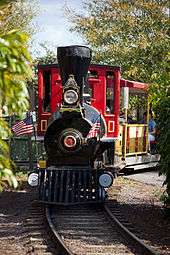
A major redevelopment of the zoo began in 1992. Through a combination of public funds and private donations, over $20 million was raised. Projects completed include a new front entry gate and parking lot, the Main Camp entrance, Birds of the Rift Valley Aviary, Great Apes, an expanded train ride, an elephant and breeding complex, RiverBranch Foundation Animal Medical Center, the PepsiCo Foundation Education Campus, and redevelopment of the 11-acre (45,000 m2) Plains of East Africa. Exhibits also include Stingray Bay, Tuxedo Coast, and the Asian bamboo garden and Komodo dragon exhibit.
In December 2003, the zoo's name was officially changed from the Jacksonville Zoo to the Jacksonville Zoo and Gardens. Over the next five years, several new exhibits and services, including the famed Range of the Jaguar, the Savanna Blooms botanical garden, and the Children's Play Park successfully opened to the public. In addition, the zoo has endeavored to become recognized as a botanical garden.
Currently, the zoo sits on 89 acres (360,000 m2) of land, over twice its original size on the Trout River location. The zoo houses over 2,400 rare and exotic animals and over 1,500 unique plant species and participates in many preservation and breeding programs to ensure the survival of endangered and threatened species as well as local fauna and flora.
Management and finance
The Jacksonville Zoological Society began managing the zoo on June 21, 1971. Originally consisting of only the seven members appointed by Mayor Tanzler, the society now consists of 85 of the city's most influential leaders. There are currently thirty Board of Trustees members, with sixteen honorary members. The board conducts business regarding the zoo in the name of the society.
The City of Jacksonville contracts with the society to manage all phases of the operation of the zoo. All property, including land, animals and equipment, belong to the city; in turn, the city contributes an annual subsidy to offset some of the zoo's operating expenses. All other zoo expenses are paid through revenues earned from admissions, concession sales, memberships, the Animal Care Club program, the Annual Fund, sponsorships, grants, and fundraising events.
Current exhibits
African exhibits
The northern part of the zoo is dominated by a series of African exhibits.
River Valley Aviary
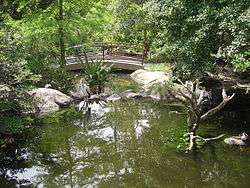
The aviary opened in April 1996 and houses a mixture of African, South American, and Asia wildlife. The enclosure has over 9,000 square feet (800 m2) for the birds to fly about and is highlighted by a large waterfall at one end of the exhibit. The aviary features lesser flamingos, Guinea fowl, storks, hammerkops, and other African birds. In late 2008, the zoo began to add Asian animals to the aviary, including a muntjac and a Victoria crowned pigeon.[4] A breeding pair of saddle-billed storks live in the enclosure. The zoo was just the sixth in the US to successfully breed this species.[5]
To the side of the main aviary is the Ruzizi Streambank. A milky eagle owl along with other smaller African birds are found there.
Mammals
Birds
- Abdim's stork
- African jacana
- African spoonbill
- Bali starling
- Blue-bellied roller
- Blue-crowned motmot
- Boat-billed heron
- Cape teal
- Chestnut-breasted malkoha
- Collared kingfisher
- Goliath heron
- Jambu fruit dove
- Javan pond heron
- Livingstone's turaco
- Mandarin duck
- Marbled duck
- Nicobar pigeon
- Oriental magpie robin
- Palm-nut vulture
- Racket-tailed roller
- Roseate spoonbill
- Saddle-billed stork
- Southern screamer
- Verreaux's eagle-owl
- White-bellied bustard
- White-crowned robin-chat
- White-faced whistling duck
- Yellow-billed stork
- White-winged wood duck
Plains of East Africa
The first major exhibit that guests encounter. The exhibit is primarily viewed from an elevated walkway giving guests a bird's eye view of the animals. The exhibit was renovated and expanded in 1996.
Nile crocodiles, warthogs, and Stanley cranes mixed with Leadbeater's ground hornbills are the first animals guests encounter. The zoo was the first in North America to successfully breed Leadbeater’s ground hornbills.[6]
Eastern bongos, pink-backed pelicans, and Egyptian geese are found in a center pen that is spacious and tree-shaded. This exhibit has become a home for a large breeding colony for the highly endangered wood stork, native to Florida.
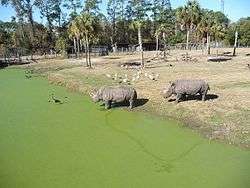
The cheetah exhibit, a 300-foot (91 m) long, 50-foot (15 m) wide area is home to two cheetahs. It lies across a water break from the larger exhibit containing southern white rhinoceroses, greater kudu, sitatungas, a north African ostrich, black-crowned cranes, and goliath herons inhabit the areas at the end of the boardwalk. This 2.5-acre (10,000 m2) exhibit allows plenty of room for the animals to roam. The zoo has been a successful breeder of southern white rhinos, with over a dozen successful births.[7]
Okapi and Grevy's zebras are located farther along the boardwalk.
Mammals
- African elephant
- African lion
- Amur leopard
- Angolan colobus
- Cheetah
- Eastern bongo
- Greater kudu
- Grévy's zebra
- Okapi
- Rock hyrax
- Southern white rhinoceros
- Straw-coloured fruit bat
- Warthog
Birds
- Blue crane
- Egyptian goose
- Grey crowned crane
- Hadada ibis
- Lappet-faced vulture
- Marabou stork
- Ostrich
- Racket-tailed roller
- Southern ground hornbill
- Violet-backed starling
- Violet turaco
- Wattled crane
- White-bellied bustard
- White-headed buffalo weaver
- Yellow-billed duck
Reptiles
- African bush viper
- African rock python
- Egyptian cobra
- Gaboon viper
- Pancake tortoise
- Puff adder
- Red spitting cobra
- Western green mamba
- Western plated lizard
Amphibians
- African bullfrog
- Painted mantella
Elephant Plaza
This offers an intimate view of the zoo's three African elephants in their 275,000-gallon pool. The zoo is one of the few to house male elephants. The male African elephant, Ali, was donated by Michael Jackson in 1997.[8] The other two, Thandi and Sheena, are females. The area features a reptile house with Egyptian cobras, green mambas, and a 12-foot (3.7 m) African rock python named Solomon. White-bellied bustards, fruit bats, klipspringers, and lappet-faced vultures are found in smaller side exhibits.
Further down the boardwalk is Mahali Pa Simba ("Place of the Lion" in Swahili), the 1-acre (4,000 m2) home of the zoo's male lions, Catali and Mshoni, and females, Tamu and Laini. The exhibit was the first to be opened and has evolved over the years. The largest change was the addition of a third viewing area across a moat on the exhibit's north side. The zoo welcomed the birth of three cubs in 2014 to mother Tamu and father Catali.
Colobus monkeys live in the area in front of the lions. From East Africa, they move by leaping from tree to tree and can be seen in action in their lively exhibit.
Leopards are along the southern end of the boardwalk. The exhibit is highlighted by the gigantic artificial tree in the center of the exhibit that the leopards love to sleep and play on. The zoo successfully bred this rare species in 2010. An interesting side note, the leopards on exhibit are Amur leopards, a subspecies native to Eastern Siberia in Russia, and one of the most endangered cat species in the world, despite their placement near an African Exhibit.[9]
Giraffe Overlook
The covered boardwalk gives guests a view across a replica of the African Savanna, and guests can also get eye-to-eye with the zoo's herd of seven giraffes. Drinks and giraffe food are sold at the overlook. The renovation more than doubled the original exhibit from 3/4 of an acre to more than 2 acres (8,100 m2). Reticulated giraffes and several other species, including wattled cranes, saddle-billed storks, and white-backed vulture, and leopard tortoise are found in this 2.5-acre (10,000 m2) exhibit, adjacent to the new Savanna Blooms botanical garden. The giraffe herd currently comprises seven individuals. Duke is the only adult male, and the females are Spock, Faraja, Naomi, and Luna. There are also two newborns, a female named Fiji and a male that has not yet been named.
African Forest (Great Apes of the World)
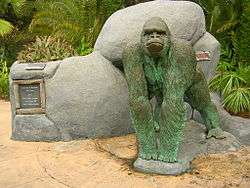
African Forest gives zoo visitors a look at the various primates that inhabit our planet. Although monkeys and strepsirrhine primates are also featured, as the previous name suggests the apes are the stars of the exhibit. The exhibit opened in two phases in 1998 and 1999 at a cost of $20 million.[10] Phase I included western lowland gorillas and bonobos, the first time the zoo had exhibited either species.[10] The zoo's collection of bonobos is one of only nine in North America.[11] The exhibit provided new homes for the zoo's siamangs and pygmy marmosets. Phase II included a second gorilla yard, along with new exhibits for the zoo's chimpanzees and mandrills, along with renovating the old monkey island area for a lemur exhibit.[10]
Since the exhibit opened, it has gradually changed over the years. The pygmy marmosets were relocated to the zoo's Range of the Jaguars exhibit in 2004 and the chimpanzees were sent to another zoo in 2007.
In 2018, this exhibit became the African Forest.
Mammals
- Black-and-white ruffed lemur
- Bonobo
- Eastern black-and-white colobus
- Mandrill
- Ring-tailed lemur
- Siamang
- Western lowland gorilla
Wild Florida
Built on the site of the old Florida Wetlands exhibit, this highlights animals native to the state, as well as some that have been extirpated. It is home to the zoo's American alligator, American black bear, Coyote, Florida panthers, white-tail deer, bobcats, bald eagles, and formerly American flamingos.
In 2007, the old flamingo exhibit was renovated to accommodate the eagles, so that their exhibit could be used for a pair of whooping cranes the zoo acquired. The reptile house in the exhibit shows off the variety of reptiles and amphibians native to the region. Eastern diamondback rattlesnakes, cottonmouths, and indigo snakes are among the main attractions.
This area is also home to the Manatee Critical Care Center. Here, manatees from the waterways of Northeast Florida and Southeast Georgia that are found to be suffering from injury, illness, or cold-stress, can be brought for treatment, recuperation, recovery, and eventual release. It is one of only four such clinics in Florida. Due to the nature of the facility, any manatees seen from the viewing area will only be present for the duration of their rehabilitation, and there may be times when no manatees are present.
Mammals
Birds
Reptiles
- Alligator snapping turtle
- American alligator
- Canebrake rattlesnake
- Corn snake
- Eastern coral snake
- Eastern diamondback rattlesnake
- Eastern glass lizard
- Eastern indigo snake
- Eastern mud turtle
- Florida box turtle
- Florida cottonmouth
- Florida pine snake
- Gopher tortoise
- Gray rat snake
- Scarlet milk snake
- Sistrurus miliarius barbouri
- Southern copperhead
- Yellow rat snake
Fish
Amphibians
- American green tree frog
- Barking tree frog
- Cuban tree frog
- Eastern newt
- Gray tree frog
- Gopher frog
- Greater siren
- Lesser siren
- Marbled salamander
- Squirrel treefrog
Invertebrates
Range of the Jaguar
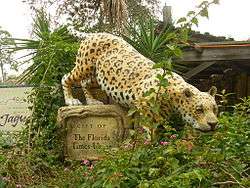
This exhibit won the 2005 AZA exhibit of the year award.[2] The exhibit is the largest in terms of number of animals. The exhibit features the largest jaguar exhibit in North America, with many pools of water for the animals to play in. In the water is a school of giant pacu. Currently, the zoo has six jaguars in its collection. One of the rare scenes in the exhibit is to see a jaguar actually fish for food. The jaguars are Zenta, Zassi, Onca, and males Tuco, Saban and Khan, named for Jacksonville Jaguars owner Shad Khan, with whom he shares a birthday. Khan was sent to the Birmingham Zoo in March 2017.[12]
The Lost Temple is constructed to look like an old Central American temple, and highlights Central and South American reptiles and amphibians such as anacondas, caiman lizards, poison dart frogs, Panamanian golden frogs, and bushmasters. Hoffman's two-toed sloths, pygmy marmosets, and cotton-top tamarins are also found in the exhibit.
The River's Edge features a pair of giant anteaters, a Baird's tapir, a pair of capybaras, a troop of squirrel monkeys, howler monkeys, and white-faced sakis (a type of monkey).
The Emerald Forest Aviary is the largest aviary on zoo grounds, housing over 100 Neotropical birds. The primary attraction is the harpy eagles enclosure, featuring a young male named Supay. In the main aviary, visitors can see macaws, cuckoos, herons, ducks, pudú, and one of the largest freshwater fish, the arapaima. As of November 2007, giant river otters have replaced the smaller otters in the aviary. Just outside the aviary are American flamingos and various swan species native to South America. [13]
Mammals
- Baird's tapir
- Black howler
- Capybara
- Cottontop tamarin
- Giant anteater
- Giant otter
- Hoffmann's two-toed sloth
- Jaguar
- Pudú
- Pygmy marmoset
- Seba's short-tailed bat
- Southern three-banded armadillo
Birds
- American flamingo
- American oystercatcher
- Black-bellied whistling duck
- Black-necked swan
- Blue-and-yellow macaw
- Blue-knobbed curassow
- Brazilian duck
- Brown pelican
- Double-crested cormorant
- Double-striped thick-knee
- Guira cuckoo
- Hooded merganser
- Inca tern
- Orinoco goose
- Plush-crested jay
- Red-and-green macaw
- Roseate spoonbill
- Scarlet ibis
- Scarlet macaw
- Sunbittern
Reptiles
- Amazon tree boa
- Arrau turtle
- Aruba island rattlesnake
- Brazilian rainbow boa
- Brown rainbow boa
- Bushmaster
- Central American river turtle
- Emerald tree boa
- Eyelash palm pit viper
- Green anaconda
- Knight anole
- Mata mata
- Meso-American slider
- Mexican beaded lizard
- Red-footed tortoise
- Taylor's cantil
Amphibians
- Blue poison dart frog
- Ornate horned frog
- Panamanian golden frog
- Red-eyed tree frog
- Vietnamese mossy frog
Fish
- Bandit catfish
- Brittlenose catfish
- Bronze catfish
- Emerald catfish
- Giant freshwater stingray
- Gold tetra
- Leopard whipray
- Pirapatinga or Giant Pacu
- Spotted hypostomus
- Suckermouth catfish
Invertebrates
Australian Adventure
Opened in March 2002, the Outback Steakhouse's Australian Adventure attraction was the first new major exhibit at the south end of the zoo in seven years. The attraction is no longer sponsored by Outback.
Included in this South Pacific attraction are the cassowary, lories and lorikeets, kangaroos, and wallabies. For a dollar, guests are given cups of nectar to feed the lorikeets. The kangaroo and wallaby exhibit originally allowed guests to walk through the area along a fenced-in path, but this was later discontinued due to concerns for the animals' safety.
Koalas were part of the exhibit from its opening until December 2006. The koalas were then sent back to the San Diego Zoo as per the terms of their lease. The koala exhibit became an Amphibian Conservation Center on February 15, 2007.[14]
Mammals
Birds
Children's Play Park
Phase one of the Jacksonville Zoo's 2.5-acre (10,000 m2) Play Park opened in May 2006 across from the Range of the Jaguar. The park replaced the outdated Okovango Village, which had been demolished a year earlier. The exhibit includes a Splash Ground water park (open seasonally) for children, an outdoor jungle gym, and a hedge maze. Animals featured include squirrel monkeys with themed activities for kids by their exhibit. In the barnyard area, children can pet farm animals like pygmy goats. The Discovery Center features educational programs.
In April, 2010 the Play Park became home to "Tuxedo Coast", a new Magellanic penguin exhibit, replacing the river otters formerly exhibited here. Underwater viewing is available to watch the penguins splash and swim in their new exhibit.
Stingray Bay
Stingray Bay opened on March 1, 2008, and features several species of rays housed in a 17,000-gallon, 30-by-40-foot (12 m) saltwater pool, guests are able to touch and feed both cownose ray, southern stingray, and Atlantic stingray. The exhibit replaced the Camel Rides in the same location near the Great Plains of East Africa. In 2011, the zoo took its operation over fully from an outside contractor, allowing the exhibit to stay open year-round. There is an additional fee to enter this exhibit.
Asian Bamboo Garden and Komodo dragon exhibit
The beautiful Asian Bamboo Garden opened in March 2009. It features plantings and design elements drawn from throughout Asia, and is not intended to represent a specific country or culture. Entry is from Trout River Plaza through a traditional circular moon gate. A large lotus pond and koi pool incorporate rock and water features intended to evoke Chinese yin and yang principles. An Orchid Pavilion patterned after a Japanese tea house overlooks the pond. The garden also features a Moon Bridge, reflecting the shape of the moon in the water of the lotus pool, and a bamboo grove containing a bronze sculpture of a giant panda.
Beyond the Bamboo Garden is the Komodo dragon exhibit, designed to appear as if the dragons are wandering in the back yards of a rural Indonesian fishing village on the island of Komodo.
Land of the Tiger
In 2014, the zoo opened the Land of the Tiger. It is a beautifully designed exhibit with naturalistic surroundings and built-in enrichment for the animals. As the guest enters the Land of the Tiger, two species of hornbills can be seen. Visayan warty pigs live in a large enclosure. The Asian small-clawed otter and the babirusa pigs share an exhibit with a heated pool.
The zoo has two breeds of tigers: two Malayan tigers, one male Jaya and from the Palm Beach Zoo and one female Cinta from Busch Gardens Tampa Bay, and five Sumatran tigers, one male named Berani, one female named Lucy, their daughter Kinleigh Rose, and their sons Rocky and Jaggar. The tigers are in a state-of-the-art exhibit which features a walk-through tunnel system that allows the tigers to choose where they would like to roam and grants the guests a unique opportunity to see the tigers from many vantage points.
Mammals
- Asian Small-Clawed Otter
- Malayan Tiger
- North Sulawesi Babirusa
- Sumatran Tiger
- Visayan Warty Pig
Birds
- Wreathed Hornbill
- Rhinoceros Hornbill
Animal conservation programs
Iwokrama Forest and Guyana
With the opening of the Range of the Jaguar exhibit, the zoo also unveiled its project with the nation of Guyana and the Iwokrama Forest. Signs around the exhibit show what is being done to protect the animals shown in their native habitats. The partnership allows the zoo to receive animals that would be unable to released back to the wild, such as with the 2006 addition of two jaguars which were household pets sent to the zoo from Guyana.[17][18]
Wood storks
The antelope exhibit in the Plains of East Africa has become home to a large breeding colony of wood storks. The storks return every year because of the abundance of water and fish in the immediate area. The colony has grown from just 7 nesting pairs that produced no chicks in 1999 to 82 pairs that produced 219 chicks in 2005. The zoo's colony has been deemed the most important established breeding colony of woodstorks in North Florida.[19] At the end of the 2006 breeding season, several firsts occurred. It was the first year birds that were tagged as hatching at the zoo returned to breed, along with the first sighting of a bird tagged at another rookery. At the end of the 2006 season, it is estimated over 800 chicks have been successfully raised in the colony since 2000.[20]
Species Survival Plan breeding programs
| Animal group | Common name | Scientific name | Conservation program, significant achievements |
|---|---|---|---|
| Big cats | |||
| Jaguar | Panthera onca | SSP, largest jaguar exhibit in North America, 1 successful birth | |
| Transvaal lion | Panthera leo krugeri | SSP | |
| Florida panther | Puma concolor coryi | SSP | |
| Amur leopard | Panthera pardus orientalis | SSP, 2 successful birth | |
| South African cheetah | Acinonyx jubatus jubatus | SSP | |
| Primates | |||
| Siamang | Hylobates syndactylus | SSP | |
| Bonobo | Pan paniscus | SSP, one of only zoos in North America to house species, 4 successful births | |
| Western lowland gorilla | Gorilla gorilla gorilla | SSP | |
| Mandrill | Mandrillus sphinx | SSP, 2 successful births since 2003 | |
| Ring tailed, red ruffed, and black & white ruffed lemurs | Lemur catta, Varecia variegata rubra, Varecia variegata variegata | SSP | |
| Colobus monkey | Colobus guereza | SSP | |
| Large mammals | |||
| African elephant | Loxodonta africana | SSP, one of few zoos to house male elephant | |
| Southern white rhino | Ceratotherium simum simum | SSP, over a dozen successful births have occurred since 1980; one of a few zoos worldwide to produce 2nd generation white rhino calves | |
| Eastern bongo | Tragelaphus eurycerus isaaci | SSP, several bongos born at the zoo participated in repatriation on Mount Kenya, Kenya | |
| Okapi[21] | Okapia johnstoni | Okapi Conservation Project working in the Okapi Wildlife Reserve in Democratic Republic of Congo | |
| Manatee[22] | Paenungulata Sirenia | Marine Mammal Rescue Program - Manatee Critical Care Center[23] | |
| Other mammals | |||
| Red wolf | Canis rufus | SSP | |
| Birds | |||
| Swallow-Tailed Kite | Elanoides forficatus | helped fund an aerial survey to identify breeding roosts and count birds in 2015 and 2016[24] | |
Botanical Gardens
Savanna Blooms
This first themed pocket garden was completed in spring 2005. Nestled beneath the Giraffe Overlook, visitors will find acacia groves that flank two entrances into the one-half acre garden. This unique garden, fashioned after a South African oasis, transitions from soft grasslands and fine textured acacia leaves at each entrance into a bold contemporary garden at its core. Kopje outcrops erupt from the landscape, and a weep trickles down the face of the rocks. The spring feeds a serene pool that showcases African water lilies and water edge plants. Visitors rest beneath the curved trellis laden with fragrant flowering vines and view the garden’s splendor from an internal vantage point.
Gardens of Trout River Plaza
In 2005-2007, the area encompassing the old Okovango Landing, as well as the children's play area was renovated. In September 2007, the $1.9 million Trout River Plaza botanical garden opened.[25] The area - which also includes a grassy area named "The Lawn" which will be used for special events - encompasses 1.6 acres (6,500 m2). The heart of the new addition is the 1/4 acre garden space, partially walled with a fountain with an anhinga sculpture, flower beds and a lot of hardscape. There are columns topped with flowering plants, benches for seating, and a large patio area surrounding the fountain. Seven live oaks and other native trees - red maples, magnolias, and forest pansies - have been planted in the area around the garden to provide shade.
Services
Restaurants
The Main Camp Café snack bar offers quick refreshments near the park's entrance. As part of the Range of the Jaguar exhibit, the Palm Plaza Café offers a southwestern menu. The Sweet Shop is also located in Range of the Jaguar. At the back of the zoo, near the Gardens of Trout River Plaza exhibit and the former Trout River pier entrance, is the Trout River Grill. Play Park Cafe is near the Children's Play Park.
Picnic grounds are located at the south end of the zoo's parking lot, near the Education Campus. No open fire or grills are allowed.
Education
Family Early Childhood Education [26]
Semester long programs for children ages 1 to 5. Classes take place PepsiCo Foundation Education Campus located at the south end of the Zoo's main parking lot. You do not need to enter the Zoo in order to enter the education campus. Natures Newbies are 45 minute long programs for children ages 1 to 3. Zoo Tots are 60 minutes lone and open to children ages 3 to 5.
Group Early Childhood Education [27]
This program is offered both onsite and as an outreach for children ages Pre-K through Kindergarten.
Classroom Programs [28]
Formal education programs at the PepsiCo Foundation Education Campus may be scheduled Monday through Friday, September through May at 9:30 a.m., 10:30 a.m., 11:30 a.m. or 12:30 p.m. Programs are available for Pre-K through 12th grade and have been developed in conjunction with the Next Generation Sunshine State and the Common Core Standards. Presentations focus on a grade-level appropriate subjects and may include up-close and hands-on animal encounters.
Field Trips [29]
March, April & May are the busiest months for school visits. Nearly 50,000 or 50% of the zoo's annual field trip attendance occurs during these spring months. JZG is a field trip destination for nearly 100,000 school students, teachers and chaperones every year from as far away as Columbia, SC & Savannah, GA, Orlando & Tallahassee, FL.
Homeschool Programs[30]
Zoocademy is a unique experience for Homeschool students ages 5–18, covering a range of topics in Biology, Zoology, Environmental Science and Conservation. This course runs from September 2016- March 2017.
Students ages 5–12 will meet at the Education Campus at the Jacksonville Zoo and Gardens once a month. Students ages 13–18 will attend class once every other month at the Education Campus at the Jacksonville Zoo and Gardens. Enrollment is limited to home-schooled children ages 5–18. Children will be enrolled into the appropriate age class based on their age as of September 1, 2016. In accordance with Florida state law, children must be 5 years old on or before September 1 to enroll.
After Dark Adventures[31]
The Education Department’s After Dark Adventures are unique events that take participants behind the scenes to meet the exotic animal collection up-close. After Dark Adventures take place outside of regular zoo hours. These include special events and safari sleepovers.
Zoo Camps [32]
Zoo Camps are held during school vacations. Camp programs include Zoo tours, activities and games, crafts, and hands-on encounters with animals everyday. Registration opens seasonally.
In addition to school vacations, some zoo camps are held around holidays and themed around those events.
Zoo to You Outreach [33]
This outreach program is designed to serve various groups and venues from classrooms to large auditoriums and special events. The classroom program is available for up to 30 attendees, the auditorium program serves groups of 31 to 250, and events and festivals option is available for larger functions. Age appropriate topics for Classroom and Auditorium programs are available.
Teacher and Educator Workshops[34]
Teach workshops are available for classroom teacher, home schooling parent, museum or park service educator. The Zoo’s Education Department Teacher & Educator Workshops are designed to help educators engage their students in environmental education. Topics vary and many can be counted towards continuing education requirements.
Scout Programs [35]
The Education Department offers many opportunities for scouts to learn about the animal world. Programs range from 45-minute classroom programs to sleepovers at the Zoo in various exhibit areas. Programs may include live animals, biofacts, activities, games, tours, or crafts. The zoo also offers a variety of programs that help scouts work towards their badge requirements.
Future plans
Monsoon Asia/Asian Bamboo Garden
The new Asian Garden and Komodo dragon exhibit will lead to a full Asian exhibit. This major exhibit is scheduled to be opened in two phases. The first phase will feature tigers, the first time the zoo has exhibited tigers since 1995. The second phase will feature other Southeast Asian and Indian animals including Komodo dragons and koi. The estimated cost of the new exhibit is $26 million and it awaits further funding.[25]
Renovation of the Plains of East Africa
A renovation is expected of the Plains of East Africa Exhibit in the next few years. The planned renovations include replacing many of the old post railings and putting in plexiglass so it is easier for small children and wheelchair-bound guests to see the animals. The boardwalk will be lowered in some spots to provide up-close encounters with the animals. The cheetah and white rhino exhibits will be reconfigured, allowing for a new hippo exhibit between them.
Gardens
More themed pocket and primary gardens are planned to open in the future, in coordination with new animal exhibits as they are constructed. The second primary garden is the Asian Bamboo Garden, which opened in 2009. The exhibit features a koi pond and waterfall, along with a bamboo island. A Komodo dragon exhibit is included. The garden will serve as the entrance for a new Asian exhibit currently in design.[36]
The area along the Trout River waterfront at the zoo is set to become formal botanical gardens in the future, as funding is obtained.
Gallery
References
- "Currently Accredited Zoos and Aquariums". aza.org. AZA. Retrieved 8 August 2011.
- "Jacksonville Zoo wins coveted AZA Exhibit Award". AZA. Archived from the original on 2007-08-24. Retrieved 2007-06-01.
- "Jacksonville Zoo & Gardens: About the Zoo-History". Archived from the original on 2008-12-23. Retrieved 2009-01-05.
- "Animals". Jacksonville Zoo. Retrieved 2011-09-19.
- "saddlebilled_stork". jaxzoo.org. Archived from the original on 5 October 2007. Retrieved 19 April 2018.
- "Jacksonville Zoo and Gardens: Leadbeater's Ground Hornbill". jaxzoo.org. Archived from the original on 26 January 2007. Retrieved 19 April 2018.
- "Jacksonville Zoo and Gardens: Southern White Rhinoceros". jaxzoo.org. Archived from the original on 26 January 2007. Retrieved 19 April 2018.
- "Jacksonville Zoo and Gardens: African Elephant". jaxzoo.org. Archived from the original on 1 April 2007. Retrieved 19 April 2018.
- "Jacksonville Zoo and Gardens: Things to See and Do". jaxzoo.org. Archived from the original on 26 January 2007. Retrieved 19 April 2018.
- "Going ape". Jacksonville.com. 1999-08-06. Retrieved 2011-09-19.
- "Bonobo Conservation". Jacksonville Zoo and Gardens. Archived from the original on 25 May 2013. Retrieved 29 February 2012.
- "Birmingham Zoo announces new jaguar exhibit, set to open this spring". al.com. Retrieved 19 April 2018.
- "GIANTS AMONG US". 2007-11-23. Retrieved 2007-12-02.
- "Exhibits". jacksonvillezoo.org. Jacksonville Zoo. Archived from the original on 21 December 2011. Retrieved 28 January 2012.
- http://www.jacksonvillezoo.org/listings.aspx?CID=298&SCID=406&SSCID=100073&pageID=15855&CNM=Play%20Park%20and%20Splash%20Ground
- http://www.jacksonvillezoo.org/listings.aspx?CID=298&SCID=406&SSCID=100110&pageID=16019&CNM=Land%20of%20the%20Tiger
- "New Jaguar Release". Archived from the original on 2007-09-28. Retrieved 2007-06-01.
- "Iwokrama News & Events - Iwokrama Develops Model Partnership for Conservation". iwokrama.org. Archived from the original on 28 September 2007. Retrieved 19 April 2018.
- "Jacksonville Zoo and Gardens: Wood Stork". jaxzoo.org. Archived from the original on 26 January 2007. Retrieved 19 April 2018.
- "Wood Storks". jaxzoo.org. Archived from the original on 5 October 2007. Retrieved 19 April 2018.
- "Jacksonville Zoo". www.jacksonvillezoo.org. Retrieved 19 April 2018.
- "Jacksonville Zoo". www.jacksonvillezoo.org. Retrieved 19 April 2018.
- "Jacksonville Zoo". www.jacksonvillezoo.org. Retrieved 19 April 2018.
- "Jacksonville Zoo". www.jacksonvillezoo.org. Retrieved 19 April 2018.
- ROGER BULL (2007-09-14). "A GARDEN PLAZA". Retrieved 2007-12-02.
- "Jacksonville Zoo". www.jacksonvillezoo.org. Retrieved 19 April 2018.
- "Jacksonville Zoo". www.jacksonvillezoo.org. Retrieved 19 April 2018.
- "Jacksonville Zoo". www.jacksonvillezoo.org. Retrieved 19 April 2018.
- "Jacksonville Zoo". www.jacksonvillezoo.org. Retrieved 19 April 2018.
- Jacksonville Zoo: Homeschool Programs
- "Jacksonville Zoo". www.jacksonvillezoo.org. Retrieved 19 April 2018.
- "Jacksonville Zoo". www.jacksonvillezoo.org. Retrieved 19 April 2018.
- "Jacksonville Zoo". www.jacksonvillezoo.org. Retrieved 19 April 2018.
- Jacksonville Zoo: Teacher and Educator Workshops
- "Jacksonville Zoo". www.jacksonvillezoo.org. Retrieved 19 April 2018.
- ROGER BULL (2007-05-26). "Look's like August for zoo's new garden area". Retrieved 2007-12-02.
External links
| Wikimedia Commons has media related to Jacksonville Zoo. |


